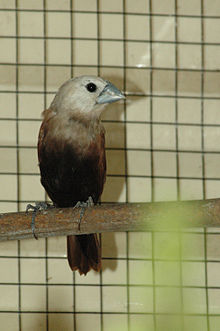White-headed munia
| White-headed munia | |
|---|---|

| |
| Scientific classification | |
| Kingdom: | |
| Phylum: | |
| Class: | |
| Order: | |
| Family: | |
| Genus: | |
| Species: | L. maja
|
| Binomial name | |
| Lonchura maja (Linnaeus, 1766)
| |
| Synonyms | |
|
Loxia maja Linnaeus, 1766 | |
The white-headed munia (Lonchura maja) is a species of estrildid finch found in Indonesia, Malaysia, Singapore, Thailand and Vietnam. This species is also introduced to Portugal. It is found in wetlands habitat. The status of the species is evaluated as Least Concern.
Description
Smallish (11 cm), white headed brown finch. Similar to the chestnut munia but paler brown and entire head and throat white. Young birds are brown on upperparts with underparts and face buff. Iris-brown; bill-grey; feet-pale blue. Voice: high-pitched 'pee-pee'.
Distribution and status
Malay peninsula, Sumatra, Java, Bali and Celebes. In Java and Bali this is a fairly common and widespread bird up to 1500 m.
Behaviour
It frequents marshes and reedbeds. Like other munias form large flocks during rice harvest but spread out in pairs during breeding season. General behaviour similar to other munias.
Feeding
Rice and Grass seeds.
Breeding
Four to five, occasionally six, white eggs are laid in a typical munia ball-shaped grass nest. Breeding is recorded in West Java for February.
Origin
Origin and phylogeny has been obtained by Antonio Arnaiz-Villena et al..[2] Estrildinae may have originated in India and dispersed thereafter (towards Africa and Pacific Ocean habitats).
References
- ^ Template:IUCN
- ^ Arnaiz-Villena, A; Ruiz-del-Valle V; Gomez-Prieto P; Reguera R; Parga-Lozano C; Serrano-Vela I (2009). "Estrildinae Finches (Aves, Passeriformes) from Africa, South Asia and Australia: a Molecular Phylogeographic Study" (PDF). The Open Ornithology Journal. 2: 29–36. doi:10.2174/1874453200902010029.

